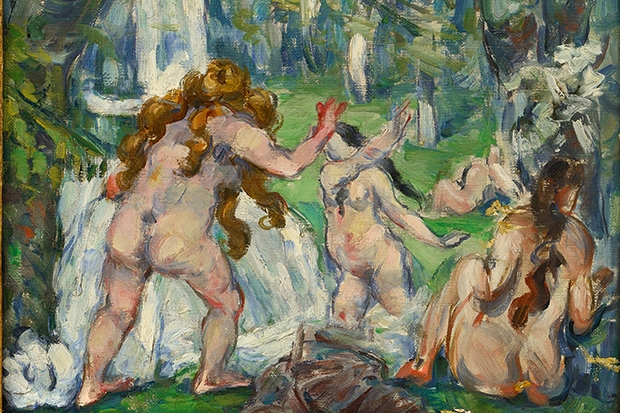The main spring offering at the Royal Academy, Rubens and His Legacy: Van Dyck to Cézanne, teaches two useful lessons. One — not much of a surprise — is that Peter Paul Rubens (1577–1640) was a protean giant of a painter, expending sufficient artistic invention and energy to power other artists for centuries to come. The other conclusion is how hard compare-and-contrast exhibitions of this kind are to pull off.
The basic idea — that Rubens was a towering figure in European culture — is plainly valid (the best riposte to the tired observation that there are so few famous Belgians is that there are plenty of celebrated Flemings, among whom Rubens is pre-eminent). Demonstrating this in visual terms, however, involves piling up umpteen examples of later artists influenced by the great man. Most of these fail to come up to the grand original, some miserably.
Furthermore, the displays are arranged thematically, under such headings as ‘Lust’ — or nudes and mythological subjects — and ‘Compassion’, meaning Rubens’s religious works. The recent Rembrandt: The Late Works at the National Gallery was organised along similar lines. There, however, the fact that the themes made little visual sense on the walls scarcely mattered since the basic ingredients — one great Rembrandt masterpiece after another — were overpowering. At the RA, however, though there are some marvellous works by Rubens, these are rationed out — sometimes only a few per room — and surrounded by pictures by later and often lesser painters.
So it is almost tempting to conclude that this is one of those projects that work better as a book than an exhibition. Almost, but not quite: one gallery is so magnificent as to be worth the price of admission in itself. It contains ‘The Garden of Love’ (1635), one of Rubens’s most compelling masterpieces, painted for his own satisfaction, a picture so rich in subject matter — courtship, beauty, fertility, the abundant pleasures of life — and so brilliant in painterly execution that you could stand in front of it for hours.
This is surrounded by Rubens’s preparatory drawings and works by Watteau, proving what fertile effect ‘The Garden of Love’ had on the art of the future. Here at least the legacy seems worthy of Rubens. An entire genre — the 18th-century French fête galante — visibly evolved from a single idea of the great man’s.
Elsewhere, it’s a patchy and sometimes lowering experience. The third room, for example, is assigned to ‘Elegance’, which means portraiture. It contains a show-stopper of a Rubens from Kingston Lacy, ‘Maria Grimaldi and Dwarf’ (c.1606), an almost surreal exercise: the attendant’s huge head is at least twice the size of the noblewoman’s neat little face, which is framed in a ruff the size of a bicycle wheel. This hangs next to a full-length double portrait by Rubens’s sometime collaborator and at one point almost alter ego, Van Dyck: ‘A Genoese Noblewoman and Her Son’ (c.1626).
Van Dyck just about survives the comparison, being better at evoking aristocratic sophistication, while Rubens outshines him in life and pizzazz; but every other painting in the room looks sad, especially those by poor Joshua Reynolds. You’d think that the Royal Academy, of all places, could come up with some less dough-coloured and lumpy specimens of work by its first president.
The gallery entitled ‘Power’, devoted to the master’s grand political/allegorical cycles, is disastrous. The problem is that there isn’t a full-scale example of a single one of these, presumably because they are too big and important to move. Instead the grand ceiling paintings of the Banqueting House, Whitehall, and the even more splendid cycle done for Marie de Médicis, mother of the King of France, are illustrated on a video screen. As a result everything else in the room looks dingy. It is a truth often demonstrated by contemporary art exhibitions that film and painting do not coexist happily in the same space.
Several other rooms seem underpowered because they lack a Rubens of sufficient wattage. The section on religious art really required one of his full-scale altarpieces, intensely emotional and wildly flamboyant visual extravaganzas packed with devotional drama, suffering saints and fluttering cherubs. Admittedly, one of those would have been hard to obtain on loan, but the medium-sized, moderate-quality triptych on show ‘Christ on the Straw’ (1617–18) is just inadequate. Here and elsewhere one begins to wonder whether various followers from Antonio Verrio to Arnold Böcklin wouldn’t have been better off having their own ideas rather than imitating Rubens’s.
On the other hand, there are marvellous things hidden away, sketches such as a tiny one for ‘The Rape of the Daughters of Leucippus’ (1610–11), in which a knot of clothes and naked bodies is transformed into a single, fluid form like a kinetic sculpture. And scattered here and there are wonderful pictures by Watteau, Delacroix and Constable, all of whom hold their own in this challenging context.
The exhibition ends with a coda of contemporary and modernist work, selected by the painter Jenny Saville and including works by Picasso, de Kooning, Bacon and Freud plus an imposing new picture of her own. This is a drastic change of gear, but a beautifully chosen display in itself. I suggest having a break and a coffee and returning to look at this room with a fresh eye.






Comments